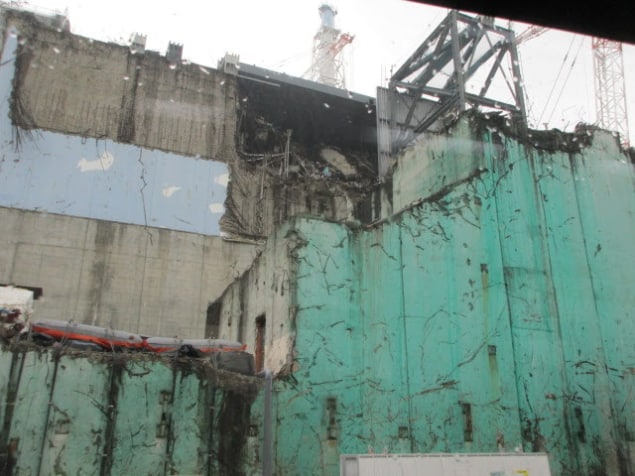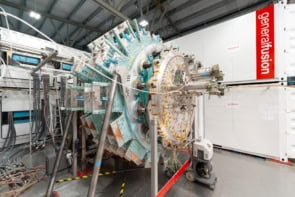
Tiny fragments of plutonium may have been carried more than 200 km by caesium particles released following the meltdown at the Fukushima Daiichi nuclear power plant in Japan in 2011. So says an international group of scientists that has made detailed studies of soil samples at sites close to the damaged reactors. The researchers say the findings shed new light on conditions inside the sealed-off reactors and should aid the plant’s decommissioning.
The disaster at Fukushima occurred after a magnitude-9 earthquake struck off the north-east coast of Japan and sent a 14 m-high tsunami crashing over the plant’s seawalls. With low-lying back-up generators knocked out, the site’s three operating reactors overheated and melted down. At the same time, hot steam reacted with the zirconium cladding of the nuclear fuel, generating hydrogen gas that exploded when it escaped from containment.
Caesium is a volatile fission product created in nuclear fuel. During the Fukushima meltdown, it combined with silica gas created when melting fuel and other reactor materials interacted with the concrete below the damaged reactor vessel. The resulting glass particles, known as caesium-rich microparticles (CsMPs), measure a few microns or tens of microns across.
Satoshi Utsunomiya and Eitaro Kurihara at Kyushu University and colleagues in Japan, Europe and the US analysed three such particles obtained from soil samples dug up at two sites within a few kilometres of the Fukushima plant. They used a range of techniques to study the physical and chemical composition of these CsMPs, with the aim of establishing whether they contained any plutonium.
Mapping plutonium spread
To date, plutonium from the accident has been detected as far as 50 km from the damaged reactors. Researchers had previously thought that this plutonium, like the caesium, was released after evaporating from the fuel. But the new analysis instead points to some of it having escaped from the stricken plant in particulate form within fragments of fuel “captured” by the CsMPs.
Utsunomiya and colleagues used electron microscopy and synchrotron X-ray fluorescence to look inside the CsMPs. Based on these data, they were able to map the distribution of various elements coming from materials within the damaged reactors – including iron from stainless steel, zirconium and tin from the fuel cladding and zinc from cooling water. They also found uranium within one of the CsMPs, in the form of discrete uranium oxide particles less than 10 nm across.
However, the researchers were unable to find any traces of plutonium using these methods – probably due to interference from strontium, another fission product. Instead, they turned to X-ray absorption. To compensate for high levels of noise, they carried out the measurement at two different synchrotrons, transporting their roughly 20 µm diameter particle from Japan to be blasted with X-rays at the Diamond facility in the UK and the Swiss Light Source in Switzerland.
The researchers focused their attention on the three areas of the particle that generated the most fluorescence from uranium. They failed to detect plutonium at two of these locations, but succeeded at the third, with absorption spectra produced at both synchrotrons indicating the element’s presence. The low signal-to-noise ratio meant they couldn’t identify exactly which plutonium species were present, but the shape of the spectra told them that it probably existed as an oxide, rather than as a pure metal.
Utsunomiya and co-workers also used mass spectrometry to measure the relative abundance of different plutonium and uranium isotopes within the microparticles. They found that three ratios – uranium-235 to uranium-238, as well as plutonium-239 compared to both plutonium-240 and -242 – all agreed with calculations of the proportions that would have been present in the fuel at the time of the disaster. This agreement, coupled with the fact that the measured amount of uranium-238 was nearly two orders of magnitude greater than would be the case if it had simply evaporated from the melted fuel, led them to conclude that the uranium and plutonium existed as discrete fuel particles within the CsMPs.
Implications for decommissioning
The researchers note that previous studies have shown that plutonium and caesium are distributed differently in the extended area around Fukushima, which suggests that not all CsMPs contain plutonium. However, they say that the fact plutonium is found in some of these particles implies that it could have been transported as far afield as the caesium – up to 230 km from the Fukushima plant.
As regards any threat to health, they note that radioactivity levels of the emitted plutonium are comparable with global counts from nuclear weapons tests. Such low concentrations, they say, “may not have significant health effects”, but they add that if the plutonium were ingested, the isotopes that make it up could yield quite high effective doses.

What next for Fukushima?
With radiation levels still too high for humans to enter the damaged reactors, the researchers argue that the fuel fragments they have uncovered provide precious direct information on what happened during the meltdown and the current state of the fuel debris. In particular, Utsunomiya points out that the composition of the debris, just like that of normal nuclear fuel, varies on the very smallest scales. This information, he says, will be vital when it comes to decommissioning the reactors safely, given the potential risk of inhaling dust particles containing uranium or plutonium.
The research is reported in Science of the Total Environment.



